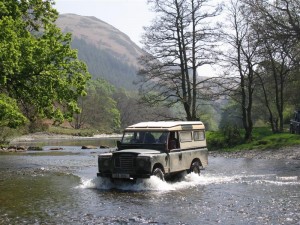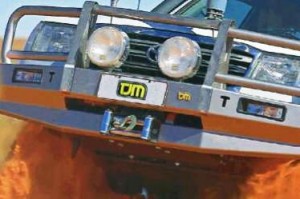What is a 4×4, 4WD and AWD?
4×2 are vehicles, driven by only two of their four wheels.
4×4 or 4WD are vehicles, driven by all four wheels, either permanent or when so selected.
AWD or Constant 4WD are vehicles driven by all the wheels.
The above statements are true, but are subject to interpretations and perceptions over many years. To further explain, a 4×2 vehicle is, as is found by the majority of cars on the roads. The family sedan and most of the pick-ups seen on the road are vehicles driven by either the rear or the front wheels.
Up till the earlier 80’s the majority of cars and pick-ups were rear wheel driven. Even though front wheel driven cars were being manufactured before the 80’s, their popularity increased rapidly from the mid 80’s onwards. Pick-ups, light utilities and vans with front wheel drive only started gaining popularity to the end of the century. Most manufacturers and customers still prefer rear wheel drive for larger and load carrying vehicles.
A 4×2 vehicle is in fact at times only a 4×1. In order for a vehicle to be able to turn, the outside wheels need to cover a further distance than those on the inside. This is made possible by the differential located between the front or rear wheels, depending whether front or rear wheel driven. One wheel is disengaged to allow all the power and drive is handled by the other wheel. The drive is normally send to the wheel with the least amount of traction, which will be the inside wheel.
The amount of slip between the two wheels depend on the differential, but for all practical reasons, a 4×2 is a 4×2 only till one wheel is forced to cover a further distance than its apposing wheel, then our 4×2 becomes a 4×1.
AWD – All Wheel Drive
AWD is the term mostly used by makers of “soft” 4×4’s. These vehicles are mostly sedans, wagons and sports cars that normally have a 4×2 model available to. Manufactures prefer using AWD to indicate the use of the vehicle is predominantly aimed at on-road use as apposed to 4×4 or 4WD for those models aimed at off-road use.
 AWD’s can be 4×4’s with constant four wheel drive, as in the Range Rover. However the predominant thought is to refer to AWD’s as the more road going version of 4WD’s or 4×4’s.
AWD’s can be 4×4’s with constant four wheel drive, as in the Range Rover. However the predominant thought is to refer to AWD’s as the more road going version of 4WD’s or 4×4’s.
AWD cars are popular with those manufacturers who compete in dirt rallies, example Subaru WRC, Mitsubishi Evo, Citroen _ _. The AWD provide maximum traction on loose surfaces. These cars brilliant at what they are designed for, but when the road, or no road surface becomes too uneven, they are let down by ground clearance. Some manufactures have AWD models with more ground clearance and electronic traction aids, example VW Tourec, Volvo _ _, BMW M5, _ _ . These AWD are a very good compromise between a normal road going and a off-road vehicle. In most cases, these type of “4×4’s” safer on-road than the every-day family saloon. For fast dirt road driving, the AWD will be safer than most 4×4’s, especially the suspension lifted and fully accessorized custom trucks. Where an AWD can very successfully replace a 4×2 saloon or family wagon for most types of road conditions, it will never go where a 4×4 can go. Do not think because your vehicle is driven by all “fours” you can now follow those in vehicles like Land Cruiser, Jeep Wrangler or Land Rover. The most advanced AWD traction control system in a vehicle without adequate ground clearance and wheel articulation is of little use when the road becomes a goat track. Apart from clearance and articulation limitations, AWD are not made for suspension, chassis and body twisting torture as those vehicles that are purpose built to handle extreme punishment. AWD’s are not built with this sort of terrain in mind and owners should not attempt to use them in off-road situations if they want to avoid vehicle damage and being stuck more than not.
4×4 or 4WD
 4WD is the term mostly used by manufactures when they refer to 4×4. A 4WD can also be truck with twin rear axles where the second axle is used as a drive axle too, as in most of these cases. Some truck manufactures use the second axle for higher load carrying ability; these axles are referred to as lazy axles. For all practical reasons and as intended by some manufacturer and to avoid an argument, a 4WD is a 4×4, a vehicle with 2 axles driven by all four wheels.
4WD is the term mostly used by manufactures when they refer to 4×4. A 4WD can also be truck with twin rear axles where the second axle is used as a drive axle too, as in most of these cases. Some truck manufactures use the second axle for higher load carrying ability; these axles are referred to as lazy axles. For all practical reasons and as intended by some manufacturer and to avoid an argument, a 4WD is a 4×4, a vehicle with 2 axles driven by all four wheels.
Most 4×4’s can be selected to be two wheel or four wheel drive via a centre differential. Manufacturers like Land Cruiser, Land Rover and _ _ have models available that are constant 4×4 and can not be selected for two wheel drive. When referring to 4×4 or 4WD, manufacturers the serious off-roaders have AWD’s in mind with more serious off-road capabilities, compared to the more soft-road AWD.
As in the case of a 4×2 vehicle, which at times can be only a 4×1 the 4×4 can at times be a 4×4, a 4×3, a 4×2, a 4×1, or sadly a 4×0. The reason why some of us go four wheel driving is to experience moments of 4×0, or more commonly referred to as being bogged. Mostly you hope it happens to your mates, so you can be the one to recover them. In AWD or with four wheel drive selected, both axles turning are turning. When the centre differential is locked, the two axles will rotate at the same speed, giving you potential 4WD. When in a straight line with equal traction at all four wheels, your 4×4 is a proper 4×4. The moment some of the wheels are forced to slow down of speed up compared to the rest, you are going to loose 4×4. This is true for all differentials except those fitted with positive locked differentials like the ARB and TJM Airlockers. These differential locks are all  manually activated by the driver. The reason wheels loose there dive can be one or a combination of reasons. When the vehicle is turning, the two inside wheels are forced to slow down while the outside two are speeding up. Without this slip in the differential it would be impossible for the vehicle to turn. When one wheel finds good traction and the opposite wheel on the same axle is on a very slippery surface, then the drive will go to the wheel with no traction. Similar when driving at large sideways angels, the two wheels on the high side of the track will have little weight on them compared to the two on the low side. In some cases this is not a problem for forward momentum; the problem comes when there is an incline or second obstacle too. The two wheels on the high side will not have the traction to help you forward. A very common occurrence is when the two wheels diagonally across loose traction, in Australia known as Wombat holes. This is due to the previous vehicles with little suspension travel and no differential locking aids. As the one wheel looses traction and receives all the drive it will start slipping, thus creating a hole. As the hole is dug by the spinning wheel, the weight is transferred to that side as the vehicle is now lower at that quarter. The result is, weight is lost diagonally across too, causing that wheel to spin too. And there you have it, a 4×4 on a level surface with no forward or reverse momentum. This is maybe not as it all starts and ends, but every time a vehicle loses traction and spins a wheel, the track will be more difficult for those who follow. Thanks to a variety of traction aids and good suspension articulation, a 4×4 can be a true 4×4 and get us not stopped at the first river crossing, but deep into the jungle.
manually activated by the driver. The reason wheels loose there dive can be one or a combination of reasons. When the vehicle is turning, the two inside wheels are forced to slow down while the outside two are speeding up. Without this slip in the differential it would be impossible for the vehicle to turn. When one wheel finds good traction and the opposite wheel on the same axle is on a very slippery surface, then the drive will go to the wheel with no traction. Similar when driving at large sideways angels, the two wheels on the high side of the track will have little weight on them compared to the two on the low side. In some cases this is not a problem for forward momentum; the problem comes when there is an incline or second obstacle too. The two wheels on the high side will not have the traction to help you forward. A very common occurrence is when the two wheels diagonally across loose traction, in Australia known as Wombat holes. This is due to the previous vehicles with little suspension travel and no differential locking aids. As the one wheel looses traction and receives all the drive it will start slipping, thus creating a hole. As the hole is dug by the spinning wheel, the weight is transferred to that side as the vehicle is now lower at that quarter. The result is, weight is lost diagonally across too, causing that wheel to spin too. And there you have it, a 4×4 on a level surface with no forward or reverse momentum. This is maybe not as it all starts and ends, but every time a vehicle loses traction and spins a wheel, the track will be more difficult for those who follow. Thanks to a variety of traction aids and good suspension articulation, a 4×4 can be a true 4×4 and get us not stopped at the first river crossing, but deep into the jungle.
